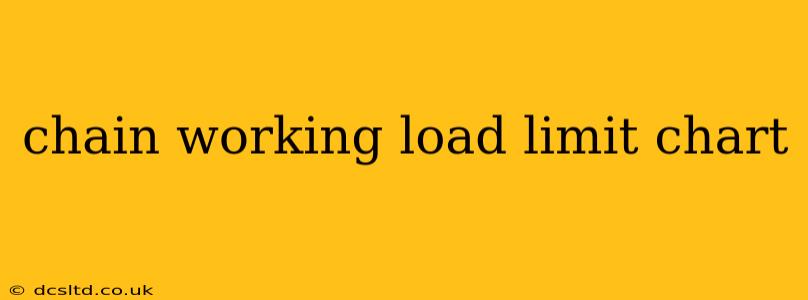Understanding chain working load limits is crucial for safety and efficiency in various industries, from construction and manufacturing to agriculture and logistics. A chain's working load limit (WLL) is the maximum load it can safely support under normal operating conditions. Exceeding this limit can lead to catastrophic failure, resulting in injury or damage. This guide will delve into chain WLL charts, their interpretation, factors influencing load limits, and best practices for safe chain usage.
What is a Chain Working Load Limit Chart?
A chain working load limit chart provides a visual representation of the safe working load for different types of chains based on their size (diameter or grade) and configuration (single leg, multiple legs, etc.). These charts are essential tools for ensuring safe operation and preventing accidents. They typically specify the maximum load a chain can handle without permanent deformation or failure. Different standards and countries may have slightly different charts, so it's crucial to use the chart that corresponds to the chain's certification and manufacturing standards.
How to Read a Chain Working Load Limit Chart
Chain WLL charts usually present data in a tabular format. They typically list the chain's:
- Size: This is often specified by the diameter of the chain links.
- Grade: The grade indicates the chain's strength and material properties. Higher grades generally mean higher WLLs.
- Configuration: This refers to how the chain is used – single leg, double leg, choker hitch, etc. The configuration significantly impacts the effective WLL.
- Working Load Limit (WLL): This is the maximum safe load the chain can handle under specified conditions. This is usually expressed in kilograms (kg) or pounds (lbs).
Example: A chart might show that a Grade 80 chain with a 10mm diameter has a WLL of 2,000 kg in a single leg configuration, but only 1,000 kg in a double-leg configuration. This illustrates how configuration greatly influences load limits.
Factors Influencing Chain Working Load Limits
Several factors can influence a chain's working load limit:
- Chain Grade/Material: Higher-grade chains (e.g., Grade 70, Grade 80) are made from stronger materials and have higher WLLs.
- Chain Diameter: Larger diameter chains have a greater cross-sectional area, leading to increased strength and higher WLLs.
- Chain Length: While not always explicitly stated on charts, excessively long chains can experience increased sag and stress, effectively reducing their WLL.
- Chain Condition: Damaged, corroded, or worn chains have significantly reduced WLLs and should be replaced.
- Configuration: As mentioned earlier, the method of using the chain (single leg, double leg, etc.) drastically affects the WLL. Angle of pull also impacts the effective load on the chain.
- Environmental Factors: Extreme temperatures, corrosive environments, and other environmental factors can weaken chains and reduce their WLL.
What Happens If You Exceed the Chain Working Load Limit?
Exceeding the WLL can lead to:
- Permanent Deformation: The chain links may become permanently stretched or deformed, compromising its integrity.
- Chain Failure: The chain may break, potentially causing injury or damage to equipment and property.
- Sudden Snapping: In extreme cases, the chain can snap without warning, presenting significant safety hazards.
Where Can I Find a Chain Working Load Limit Chart?
Chain WLL charts are often available from:
- Chain Manufacturers: Reputable manufacturers provide WLL charts for their products. Always consult the manufacturer's documentation for your specific chain.
- Lifting Equipment Suppliers: Companies that supply lifting equipment often provide WLL charts for various chain types.
- Online Resources: While online resources can be helpful, always verify the information with the manufacturer or a qualified professional.
How Often Should I Inspect My Chains?
Regular inspection is vital for chain safety. Visual inspections should be conducted before each use, looking for signs of wear, damage, corrosion, or deformation. A more thorough inspection, potentially involving a qualified professional, should be carried out at regular intervals depending on usage frequency and environmental conditions.
What are the different types of chain configurations and their WLL impact?
Different chain configurations lead to different load distributions and thus different working load limits. For example:
- Single-leg lift: The entire load is carried by a single strand of chain. This gives the highest WLL for a given chain size.
- Double-leg lift: The load is shared between two strands of chain. The WLL is typically half that of a single-leg lift for the same chain size.
- Choker hitch: This configuration forms a loop around a load. The angle of the hitch significantly impacts the WLL and requires careful consideration.
- Basket hitch: Similar to a choker hitch, but with three legs or more, better distributing the load.
Always consult a load-distribution chart to ascertain the correct WLL for your specific chain and configuration.
This guide provides a comprehensive overview of chain working load limits. Remember, safety should always be the top priority when working with chains. Always consult appropriate charts and adhere to safety regulations to prevent accidents. If you are unsure about any aspect of chain usage or selection, seek advice from a qualified professional.
